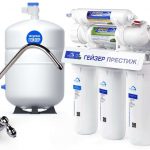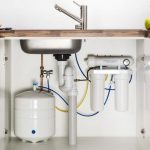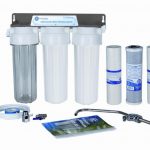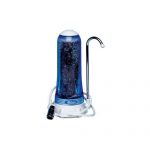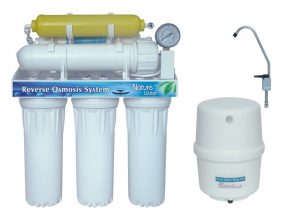 Given the varying degree and type of possible contamination, manufacturers are forced to create advanced types of filters for water treatment, among which the membrane is one of the most common. What is the principle of its technology of "processing" fluid? What characteristics should be guided by when choosing a membrane filter to modify the composition of water? Will the choice in favor of this product really become ideal from the point of view of the ratio “price - quality”? We are ready to share with you our knowledge on this subject in the article below.
Given the varying degree and type of possible contamination, manufacturers are forced to create advanced types of filters for water treatment, among which the membrane is one of the most common. What is the principle of its technology of "processing" fluid? What characteristics should be guided by when choosing a membrane filter to modify the composition of water? Will the choice in favor of this product really become ideal from the point of view of the ratio “price - quality”? We are ready to share with you our knowledge on this subject in the article below.
Content
What it is
The design of the membrane-type filtering device is based on the main cleaning element - a synthetic cartridge, otherwise called the membrane professionals. Its main purpose is to separate the total received water flow into purified water and that which is designed to wash away “production waste” after direct filtration into the drainage. The liquid directed into the membrane under pressure, passing through it, is cleaned, leaving harmful impurities inside the structure. The second part of the total volume of water, following the first, “washes” the membrane, taking away the left “garbage” into the drain.
It is important to note that, after going through the main stage of filtration, the purified liquid retains in its chemical and mineral composition the optimal ratio of useful elements, as much as possible with careful "processing".
After purification in the membrane, the water undergoes "distribution" in a special storage device - a hydraulic accumulator. Given the average daily rate of the process of "processing" the liquid, from 200 to 400 liters, if necessary, filtering large volumes of this indicator may not be enough. To this end, from each cycle described above, some of the "pure" product is "discharged" into the storage tank. In case of urgent need for a huge amount of water, the filter will “give out” the deferred reserves.
Of course, during prolonged storage in a hydraulic accumulator, the accumulated liquid can deteriorate and acquire an unpleasant smell or taste. To prevent an imbalance in the mineral composition of water, manufacturers recommend installing a so-called post-filter after the membrane and the storage element. Thanks to its carbon composition, it is able to eliminate the undesirable properties of a liquid that can arise due to prolonged accumulation.
Some membrane filters are equipped with an optional mineralizing cartridge. Passing through it, water will be able to replenish the content of nutrients lost during deep purification in the first stages of the system. Such circulation is the basic technology for filtering contaminated water using a membrane filter.
Types of Membrane Filters
Having understood the basic principle of operation of the considered type of treatment devices, it is worth paying special attention to their classification. As a membrane cartridge, “cleaners” are divided into:
- ultrafiltration (pore diameter from 0.2 to 0.02 microns);
- reverse osmotic (0.001 - 0.0001 μm);
- nanofiltration (pore diameter from 0.01 to 0.001 μm).
In the first case, the pore size of the membrane is designed to thoroughly rid the water of the vast majority of bacteria, salts, metals and harmful substances, without allowing, due to their superior diameter, to “leak” into the purified stream.At the same time, the design is provided in such a way that smaller “useful” elements and minerals, such as calcium or magnesium, freely “pass” through the filter cartridge, thus preserving the positive chemical composition of the water obtained as a result of the treatment process.
The design of the reverse osmosis membrane involves the separation of the "injected" volume of water into the cleanest and most concentrated pollution of various kinds. This process got its name, being the exact opposite of the osmosis system, which, in turn, is aimed at "equalizing" the density of water. The pore diameter of the cleaning cartridge is so small that it can "accept" only the smallest water molecules. However, as in the first case described above, there remains a great chance for particles of harmful substances to “bypass cleaning”, due to the size smaller in comparison with the pore diameter of the membrane. To eliminate this fact, manufacturers complete the device design with several additional pre-filters and a post-filter responsible for the final post-treatment and mineralization of water with useful substances.
Nanofiltration membranes are just used for the mentioned post-treatment. In addition to its direct purpose - to rid the liquid of residual harmful elements (heavy metals, substances, impurities, microorganisms), this type of cartridge copes well with softening the processed liquid, depriving it of most of the available volume of hardness salts.
Advantages and disadvantages
Now, having understood the basic concepts related to the structure, functioning and classification of membrane filters, it will be appropriate to formulate the most popular advantages and disadvantages of its use.
The basic positive aspects of the operation of this type of treatment devices include:
- relatively low cost, making them available for purchase by most users, not only for industrial production, but also for home installation;
- simplicity of their installation, maintenance and direct operation, carried out without minimal intervention by the owner;
- a long period of possible functioning without the need for additional cleaning or replacement of components;
- compactness of most models of the considered type of devices, allowing their use on virtually any area;
- the absence of a negative impact on the initial state of plumbing, household "helpers" and pipes, despite their direct long-term participation in the filtering process using the described method;
- the possibility of obtaining pure water at the outlet, due to the disposal of the incoming liquid from the vast majority of bacteria, microorganisms, and even some metals and hardness salts, thanks to the multi-stage thought-out filter design;
- the maximum possible preservation of the chemical and mineral composition of the processed substance.
In addition to the large number of significant advantages of membrane water filters, the user, when making the final decision, must bear in mind the disadvantages of this product. These include:
- low speed of the cleaning process, due to the passage of fluid through several devices of thorough "processing";
- the need to install additional tanks for the accumulation of water in the device;
- excessive demineralization, provided by some models of membrane-type filters, due to the "containment" of large molecules of nutrients by the pores of the cartridge.
How to choose
Having made the decision to purchase a membrane “cleaner”, the consumer should be aware of technical indicators that deserve special attention when choosing the most suitable model for themselves.
Firstly, it is important to determine the type of filter cartridge you want. This choice should be based on the need to cope with a specific task.So, for cleaning water from mechanical impurities, coupled with additional filters, polypropylene cartridges are used. It is advisable to buy a cleaning element with a carbon sorbent or an ion-exchange component with the existing goal of getting rid of hardness salts, heavy metals, chlorine molecules and other organic contaminants.
Secondly, based on the first point, the importance of laboratory analysis is able to provide reliable indicators in numbers related to problems in the chemical composition of the source water. Depending on the model, manufacturers bundle their goods with a different number of modules. For example, having revealed an increased content of hardness salts in the available water, one should give preference to the filters that are supplied with the cartridge, aimed at softening the liquid in its functionality.
Thirdly, it is advisable to pay attention to the performance indicator, illustrating the speed and real results of the cleaning process. The optimal characteristic in this case is considered to be a performance of 6 l / h.
A properly selected filter that meets the main listed indicators will not cause trouble to the user during its operation. To facilitate the process of searching for the “your dream” device, the following is a list of the top models of membrane-type treatment facilities.
The best models
Geyser Prestige (12 l)
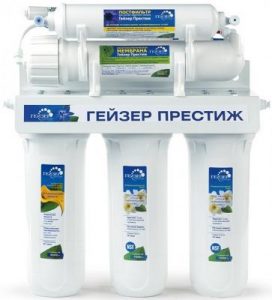
- Type of filter: under-wash system
- Purpose: for cold water supply
- Filtration method: reverse osmosis, coal purification
- Direct focus: softening, getting rid of iron and chlorine
- Maximum productivity: 0.13 l / min
- Inlet water temperature: 4 - 40 ° С
- Inlet pressure: from 3 to 10 atm-r
- Porosity - 1 micron
- easy installation
- the ability to adjust the configuration of the treatment system to the initial composition of water
- high-quality water treatment
- low structural strength
- "Discharge" of a large amount of water into the drain
- high cost of supplies
New Water Expert Osmos MO530

- Type of filter: under-wash system
- Purpose: for cold water supply
- Filtration method: reverse osmosis, coal purification
- Direct focus: softening, getting rid of iron and chlorine, enrichment with minerals and other useful substances
- Maximum productivity: 0.18 l / min
- Inlet water temperature: 5 - 35 ° С
- Inlet Pressure: 2 to 19 atm-p
- Porosity - 5 microns
- low noise generated during operation
- high-quality water treatment
- simplicity of mounting design
- need for additional space for tank installation
- cost of goods
Atoll A-550m STD
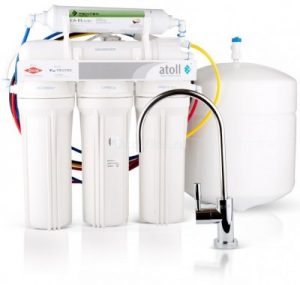
- Type of filter: under-wash system
- Purpose: for cold water supply
- Filtration method: reverse osmosis, coal purification
- Direct focus: softening, getting rid of iron and chlorine, enrichment with minerals and other useful substances
- Recommended capacity: 0.08 l / min
- Inlet water temperature: 4-38 ° С
- Inlet Pressure: 2.80 to 6 bar
- Porosity - 1 micron
- imported high quality components
- high tank volume
- the presence of a mineralizer
- simplicity of mounting design
- ill-conceived systems of discharge of "waste" into stock
- low quality of individual fasteners
- large dimensions
New Water Econic Osmos Stream OD310

- Type of filter: under-wash system
- Purpose: for cold water supply
- Filtration method: reverse osmosis, coal purification
- Direct focus: softening, getting rid of iron and chlorine
- Maximum capacity: 0.7 L / min
- Inlet water temperature: 5 - 35 ° С
- Inlet Pressure: 2 to 8 atm-p
- Porosity - 5 microns
- compactness
- simplicity in installation, care and operation
- high-quality water treatment
- low quality of "native" mounts
- high cost of supplies
- low performance
PROFI Osmo 100 barrier
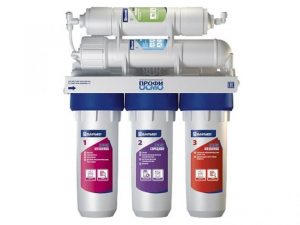
- Type of filter: under-wash system
- Purpose: for cold water supply
- Filtration method: reverse osmosis, coal purification
- Direct focus: softening, getting rid of iron and chlorine
- Recommended capacity: 0.2 l / min
- Inlet water temperature: 5 - 35 ° С
- Inlet Pressure: 3 to 7 bar
- Porosity - 1 micron
- simplicity in installation, care and operation
- filtration quality
- affordable cost
- appearance of the “output” crane
- lack of mineralizer
- "Drain" a large amount of water into the drain
Now, having an idea of a really high-quality membrane filter, you can immediately start searching for a “cleaner” of your dreams that can not only improve the quality of the water you consume, but also protect your plumbing and household appliances from premature wear.
